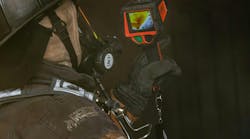How much do you know about GIS and how effectively is your organization, locality or state using GIS? If you cannot answer this question, the time has come to find out.
This article is written to support the International Association of Fire Chiefs (IAFC) Technology Council's effort to increase GIS awareness in the fire service and to encourage the development of a national GIS plan. The Technology Council's vision is to advance technological adaptation among public safety agencies.
What is GIS?
GIS is defined as a geographic information system that integrates computer hardware, software and data for capturing, managing, analyzing, and displaying all forms of geographically referenced information. GIS allows us to view, understand, question, interpret and visualize data in many ways that reveal relationships, patterns and trends in the form of maps, globes, reports and charts.
The term GIS is most often associated with maps, but mapping is only one very narrow aspect. GIS also enables analysis of data and problem solving. Combining global positioning systems (GPS), data from sensors (flood gauges, radiological, road temperature, etc.) and interacting with rules by exception creates a new result of dynamic mapping/monitoring and change the paradigm from a static-reactive process to proactive forecasting. If a picture paints a thousand words, then it is appropriate to say that GIS paints a million.
This was better described during a recent presentation by Virginia Department of Emergency Management (VDEM) Operations Chief Chris McIntosh as "GIS with Brains." VDEM is piloting a dynamic GIS project called the Virginia Interoperability Picture for Emergency Response (VIPER).
The Value of GIS
The value of GIS is particularly compelling during the present economic downturn. GIS is an invaluable tool to conduct a combined analysis of department resources, community risk and response trends. GIS can provide a snapshot of the current community response/risk data relative to the decreasing available resources (personnel, apparatus and fire stations).
Beyond increasing efficiencies in the administration of public safety systems, GIS enhances operational effectiveness by helping personnel to clearly understand and identify community risks, develop plans to ensure adequate deployment of firefighting resources and operationalize those plans by providing information necessary to support an effective response; "saving lives by getting the right information to the right people." GIS also helps to provide a common view of data (common operating picture) that can provide all-inclusive shared situational awareness.
GIS can also be used to perform "what if" modeling to show the impact of resource relocation or fire station closures. Modeling can predict insightful and realistic outcomes that are specifically important to firefighting effectiveness and safety and survival of citizens and firefighters. An effective GIS presentation of proposed decisions empowers citizens to better understand the effect on the community service levels and accept or oppose the recommendations.
Identifying community risk zones and implementing a standard of cover are also required elements of the fire department accreditation process by the Commission on Fire Accreditation International (CFAI). An effective GIS strategy at the local level will greatly enhance this process.
GIS at the Local Level
Over the past 15 years, many discussions and articles have begun to demonstrate clearly the importance of GIS for the fire service. In the wildland firefighting community and in larger metropolitan fire departments, much progress has been made in applying the use of this technology to help fire-rescue personnel save lives and property more safely and effectively. The time is right to expand this use of GIS to the many other areas where GIS can and must be more effectively used by public safety organizations. One clear path to accomplishing this purpose is to break down the stove-pipes currently limiting the use of existing GIS assets in our communities.
Generally, GIS is already being used (and maintained) for land-management/real estate purposes by almost every local government, which means that the foundation for public safety GIS is already in place. By national data sources, most fire and police departments are submitting their incident/response data to national fire and crime databases - the National Fire Incident Reporting System (NFIRS) and National Crime Information Center (NCIC) - through local records management systems (RMS). The key to a successful local public safety GIS strategy is to interface this RMS data with the local geospatial data.
The best way to marry the emergency incident/response data with GIS is to reach out to your local GIS coordinator. It has been demonstrated repeatedly that this "handshake" is the most important and fundamental first step. Once this relationship is cemented and there is an understanding between public safety and the GIS coordinator on a common goal/purpose, meaningful results will follow in the form of maps, trend analysis, modeling and more.
A National Plan
This year, the IAFC Technology Council, the National Association of State Fire Marshals and the IAFC Metro Chiefs worked collaboratively with the Department of Homeland Security (DHS) Geospatial Management Office (GMO) to merge a fire service/hazmat data model into the national DHS data model. This was a critical first step for the fire service with much credit to Dan Cotter and his staff at the DHS GMO.
While GIS has many benefits to the fire service, the value is far greater when data is shared (and not duplicated) across disciplines and between all levels of government (tribal, local, state and federal). The development of the Statement of Requirements for future public safety GIS would be of great benefit to a diverse and collective cross section of public safety responders at every level of government. This approach, similar to that undertaken by SAFECOM for communications interoperability, is immediately achievable through existing outreach channels.
In order to move GIS forward in the most effective way possible, GIS must be addressed through a national (not federal ) GIS plan. In concert with this recommendation, the IAFC board unanimously voted on Jan. 23, 2009, to "...support the concept of GIS and the development of a national plan which includes standards for GIS; this would include the development of a strategic plan that will serve as a map to meet this goal."
The time is now to develop the national GIS plan (NGISP) that incorporates and implements collaboration across all public safety disciplines. A national plan will instill collaboration among all public safety disciplines and will engage every level of government in a way of synergy while simultaneously eliminating duplication. A national plan can jump start the process through incentive funding to local and state governments for pilot/proof-of-concept projects.
Critical to its success, a national plan must be inclusive by partnering with other mission-critical organizations (including transportation, health, public service, etc.). Lastly, the national plan must require two-way coordination and communication across and between all levels of government. A national GIS plan should also be a complementary element within the National Emergency Communications Plan (NECP).
GIS is a sleeping giant. The day has come to awaken this sleeping giant and unleash the phenomenal power that it possesses in a way that enhances public safety.
CHARLES WERNER, a Firehouse® contributing editor, is a 34-year veteran of the fire service and serves as the chief of the Charlottesville VA Fire Department. Chief Werner also serves on the Virginia Statewide Interoperability Executive Committee, the Virginia Secure Commonwealth Panel, the National Public Safety Telecommunications Council Governing Board, the IAFC Communications Committee, Chair of the IAFC Technology Council, 1st Vice President of the Virginia Fire Chiefs Association and Chair of the DHS SAFECOM Executive Committee.





